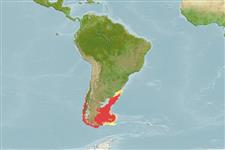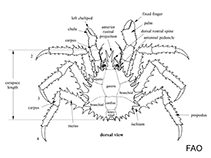Lithodes santolla (Molina, 1782)
Southern king crab| Native range | All suitable habitat | Point map | Year 2050 |

|
| This map was computer-generated and has not yet been reviewed. |
| Lithodes santolla AquaMaps Data sources: GBIF OBIS |
Upload your photos
Google image | No image available for this species;
drawing shows typical species in Lithodidae.
Google image | No image available for this species;
drawing shows typical species in Lithodidae.
Classification / Names Common names | Synonyms | CoL | ITIS | WoRMS
Malacostraca | Decapoda | Lithodidae | Lithodinae
Environment: milieu / climate zone / depth range / distribution range Ecology
Benthic; depth range 0 - 700 m (Ref. 2686). Subtropical, preferred 9°C (Ref. 107945); 34°S - 57°S, 77°W - 51°W
Distribution Countries | FAO areas | Ecosystems | Occurrences | Introductions
Southeast Pacific and Southwest Atlantic: from Chile (Talcahuano to Cape Horn), Falkland Islands, Argentina and Uruguay. Subtropical and temperate.
Length at first maturity / Size / Weight / Age
Maturity: Lm ?, range 6 - 7.5 cm Max length : 19.0 cm CL male/unsexed; (Ref. 93013); max. published weight: 8.0 kg (Ref. 93013)
Restricted to deeper waters (Ref. 2786). Intraspecific predation observed in its early stages (Ref. 104081). Juveniles are observed to form aggregations known as "pods" on large kelp Macrocystis pyrifera. Young individuals are found around the holdfasts and stipes of this kelp (Ref. 104212) as well as on rocky bottoms in the subtidal nearshore (Ref. 104371). Juveniles are voracious and opportunistic omnivorous predators (Ref. 104371). Scavenger and predator (Ref. 113323). Also in Ref. 78676.
Life cycle and mating behavior Maturity | Reproduction | Spawning | Eggs | Fecundity | Larvae
Life cycle: Females begin molting in late November to early December. Fertilization occurs right after oviposition. Embryogenesis lasts 9-10 months. Larval hatching occurs between mid-September and October. Embryos develop into lecithotrophic or facultative larvae, which passes through three zoeal and one megalopal stages, and later metamorphoses to the first benthic crab stage. Mating behavior: A precopulatory embrace occurs between an old-shelled male and a recently molted female. Females carry 5500-60000 eggs (Ref. 93013).
Main reference
References | Coordinator | Collaborators
Arana, P.M.E. and M.A. Retamal. 1999. (Ref. 2676)
IUCN Red List Status (Ref. 130435)
CITES status (Ref. 108899)
Not Evaluated
CMS (Ref. 116361)
Not Evaluated
Threat to humans
Harmless
Human uses
Fisheries: commercial
FAO - Fisheries: landings | FishSource | Sea Around Us
Tools
More information
Internet sources
BHL | BOLD Systems | CISTI | DiscoverLife | FAO(Fisheries: ; publication : search) | Fishipedia | GenBank (genome, nucleotide) | GloBI | Gomexsi | Google Books | Google Scholar | Google | PubMed | Tree of Life | Wikipedia (Go, Search) | Zoological Record
Estimates based on models
Preferred temperature
(Ref. 115969): 4.4 - 9.7, mean 6.4 (based on 330 cells).
Resilience
(Ref. 69278):
Medium, minimum population doubling time 1.4 - 4.4 years (K=0.15-0.22; tm=5).
Nutrients: Calcium = 109 [35, 184] mg/100g; Iron = 1.59 [1.21, 1.97] mg/100g; Protein = 20.2 [19.2, 21.3] %; Omega3 = 0.285 [0.185, 0.386] g/100g; Selenium = 48.3 [-31.7, 128.3] μg/100g; VitaminA = 0 μg/100g; Zinc = 1.79 [1.17, 2.40] mg/100g (wet weight).



